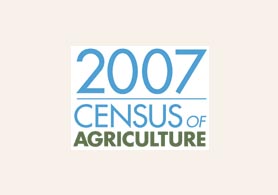AG CENSUS SHOWS MORE PEOPLE FARMING IN NEW JERSEY
Five -Year USDA Census Highlights Changing Garden State Agriculture
For Immediate Release: February 4, 2009Contact: Lynne Richmond
(609) 633-2954
(TRENTON) – New Jersey has 10,327 farms, which is 4 percent more than 2002 and the highest number since 1965, however the average farm size has decreased, according to figures released today in the 2007 United States Census of Agriculture.
The census showed the majority of New Jersey farms are less than 49 acres and the number of farms with between 1,000 and 1,999 acres decreased.
While New Jersey’s farmers receive higher prices for their agricultural products, the costs of operating a farm have risen. The census says the value of the state’s agricultural products sold has increased 32 percent to $986.9 million in 2007. However, farmers’ expenses increased from 2002 to $835.2 million, due to large hikes in the prices for fuel, fertilizer and seed.
“Despite the high cost and various challenges of being a farmer in New Jersey, the most densely populated state in the nation, we are seeing that the many benefits associated with farming close to where people live is attracting more people to farming in the Garden State,” said Acting New Jersey Secretary of Agriculture Alfred W. Murray. “In addition, New Jersey agriculture is becoming more diverse and specialized with higher value crops to meet the needs of our state and region.”
While the census reported more farms in 2007, there was a 9 percent decrease in farm acreage in New Jersey, from 805,682 acres in 2002 to 733,450 acres in 2007. The largest decreases were in Burlington, Sussex and Hunterdon counties, while the only counties showing increases in farmland were Passaic, Salem, Atlantic and Essex counties.
At the same time, the state permanently preserved 62,734 acres of farmland, helping to stem the loss of even a greater amount of farmland. Currently in 2009, 174,852 acres have been preserved since the inception of the program, permanently preserving more than 20 percent of the state’s agricultural land.
New Jersey farm operators are getting older. The average age of the principal operator of a farm in New Jersey increased to 57.1 years. The percentage of women principal operators also increased from 19.4 percent to 21.9 percent. Of the 15,936 total farm operators, 227 are under 25.
For the first time, the census looked at organic production, on-farm energy production and community supported agriculture, all growing trends in New Jersey agriculture.
The census says there are 211 organic farms on 3,449 acres with a production value of $4.25 million in New Jersey. In 2007, the USDA accredited the New Jersey Department of Agriculture to certify organic farms and processors and there continues to be increased interest in organic production.
Along with organic farming, many producers also offer the public an opportunity to buy shares in their farms through community supported agriculture operations (CSA). The census showed that 81 farms marketed their products through CSA’s. Those who participate in a CSA are entitled to a certain amount of produce grown on the farm and are sometimes required to work on the farm.
There are many New Jersey farmers who have seen the benefit of producing energy through solar panels or windmills on their farms, producing enough energy to power their own operations and sell some of the energy to local power companies. The census found that 204 farms in the state generated energy or electricity.
“New Jersey farmers are innovative, creative and hard-working, contending with many challenges, yet leading the industry into the future,” said Acting Secretary Murray.
The 2007 Census showed that even though New Jersey is a small state, it ranked in the top four nationally in the total acres of land devoted to a number of crops. The state ranked second in land for blueberries, escarole/endive and parsley; third for cranberries, fresh-cut herbs, asparagus, collard greens, eggplant and Chinese cabbage; and fourth for bell peppers, peaches and spinach.
Nursery, greenhouse, sod remains the top New Jersey agriculture sector, followed by fruits and vegetables, grains, milk, equine and poultry.
“New Jersey agriculture continues to be an important industry, contributing almost a billion dollars to our state’s economy,” said Acting Secretary Murray. “New Jersey residents place a high value on having access to a large, diverse selection of agricultural products, from Jersey Fresh produce to Jersey Grown horticultural products and Jersey Seafood, caught or harvested by our state’s fishermen. New Jersey agriculture impacts the quality of life of every citizen.
Conducted every five years by the United States Department of Agriculture (USDA), the Census is a complete count of the nation’s farms and the people who operate them. The Census looks at land use and ownership, operator characteristics, production practices, income and expenditures and other topics. It provides a source of uniform, comprehensive agricultural data for every county in the nation.
For more information on the USDA Census of Agriculture, visit www.agcensus.usda.gov.



